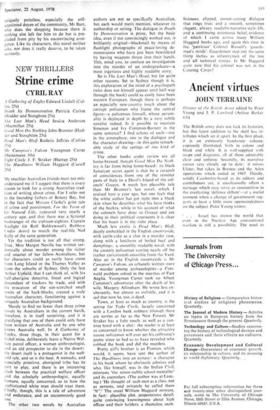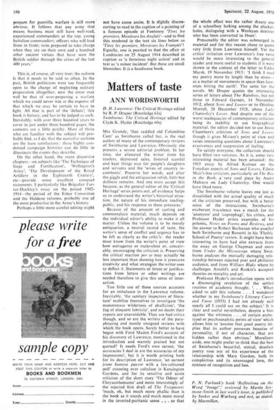Ancient virtues
JOHN TERRAINE
History of the British Army edited by Peter Young and J. P. Lawford (Arthur Barker 63s)
The British army does not lack its histories, but this latest addition to the shelf has at- tributes which set it apart. In the first place, it is an extremely handsome volume, copiously illustrated, both in colour and black and white. It is well-supplied with maps and diagrams, all of them admirably clear and unfussy. Secondly, its narrative comes very closely up to date: it misses Ulster. but lakes in Borneo and the Aden operations which ended in 1967. Thirdly. solidly Camberley-based as its editors and contributors are, it unashamedly offers a message which may serve as ammunition in the everlasting 'defence debate'—at a useful moment when a change of government sug- gests at least a little more openmindedness on the subject. Peter Young writes: . Israel has shown the world that even in the Nuclear Age conventional warfare is still a possibility. The need to
prepare for guerrilla warfare is still more obvious. It follows that any army that means business must still have well-read, experienced commanders at the top; young battalion commanders; officers who will lead from in front; NCOS prepared to take charge when they are on their own and a hundred other ancient virtues that have seen the British soldier through the crises of the last 400 years.'
This is, of course, all very true; the sadness is that it needs to be said so often. In the past, British politicians were too frequently open to the charge of neglecting military preparation altogether; now the error may well be that of over-preparing a warfare which we could never win at the expense of that which we may be certain to have to fight. All that is part of the 'debate'; this book is history, and has to be judged as such. Inevitably, with over three hundred years to cover in just under three hundred pages, the contents are a little patchy. Most of those who are familiar with the subject will pro- bably find, as I do, that the narrative sections are the least satisfactory : these highly con- densed campaign histories can do little to illuminate the events they describe.
On the other hand, the more discursive chapters—on subjects like 'The Technique of Siege and Fortification', 'Wellington's Army', 'The Development of the Royal Artillery in the Eighteenth Century', etc—provide some excellent compact statements. I particularly like Brigadier Far- rar-Hockley's essay on the period 1902- 1914—the period of the Esher Committee and the Haldane reforms, probably one of the most productive in the Army's history.
Perhaps a little more careful editing might not have come amiss. It is slightly discon- certing to read in the caption of a painting of a famous episode at Fontenoy `Tirez les premiers, Messieurs les Anglais'—and to find this rendered in the text six lines below as 'Tirez les premiers, Messieurs les Francais'! Equally, one is puzzled to find the affair at Landrecies on 25 August 1914 described in caption as 'a ferocious night action' and in text as 'a minor incident'. But these are small blemishes. It is a handsome book.































 Previous page
Previous page